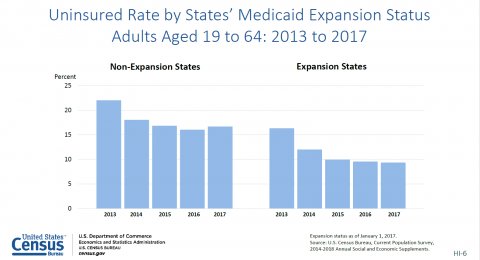New data released by the U.S. Census Bureau show that 28.5 million people did not have health insurance in 2017. As officials note, the change – actually a slight uptick from the previous year – is not statistically significant. But behind the slight movement are close to 500,000 additional people who reported that they are without health insurance – in other words, a real-world impact, according to Sara Rosenbaum, JD, the Hirsh Professor of Health Law and Policy at the George Washington University Milken Institute School of Public Health (Milken Institute SPH).
“Any loss of recent health insurance gains should be cause for concern,” Rosenbaum says. “The human factor needs to be brought out from behind these figures, and public officials need to pay real attention to the fact that current public policies may be pushing coverage in the wrong direction.”
The data show that the massive progress which the U.S. had been making in reducing the uninsured has stalled, despite the stronger economy, adds Leighton Ku, PhD, MPH, director of the Milken Institute SPH’s Center for Health Policy Research.
“The question is why, in this booming economy, are we getting this uptick?” Rosenbaum asks. “We have known for decades that the employer system doesn’t work for lower wage people. They may be working more hours and earning more money, but their wages don’t come with insurance. They depend on public coverage such as subsidized Marketplace health plans and Medicaid,” she points out. “And for people who may not be low income but have no access to employer insurance, affordable private coverage purchased individually is absolutely crucial, especially for those with pre-existing conditions. If coverage rates are falling in the non-subsidized individual market, this is another major cause for concern.”
Rosenbaum charges that “the administration is essentially trying to destabilize the market for good quality, affordable, individual policies, both inside and outside the Marketplace. The administration has reduced open enrollment and limited help to people who need enrollment assistance. It has taken steps to actively promote junk insurance in the form of short term and association health plans that don’t play by the ACA’s rules of accessible, reasonably comprehensive coverage. Furthermore, the administration has been aggressive in its efforts to convince states that not already have done so not to expand Medicaid or to start cutting back on expansions already in place through 1115 work demonstrations.”
The census data show that the rising uninsured rates are clustered in the 19 states that have not expanded Medicaid, while the numbers of insured have continued to climb in the 32 states (including Washington, DC) that have expanded Medicaid. “If you open up pathways to coverage for lower income people, the uninsured rates are going to come down,” Rosenbaum states.
“We should not have more than 28 million people without health insurance, which is where things stood in 2016. This number should be coming down, not going up, even if the increase is slight,” Rosenbaum concludes.



